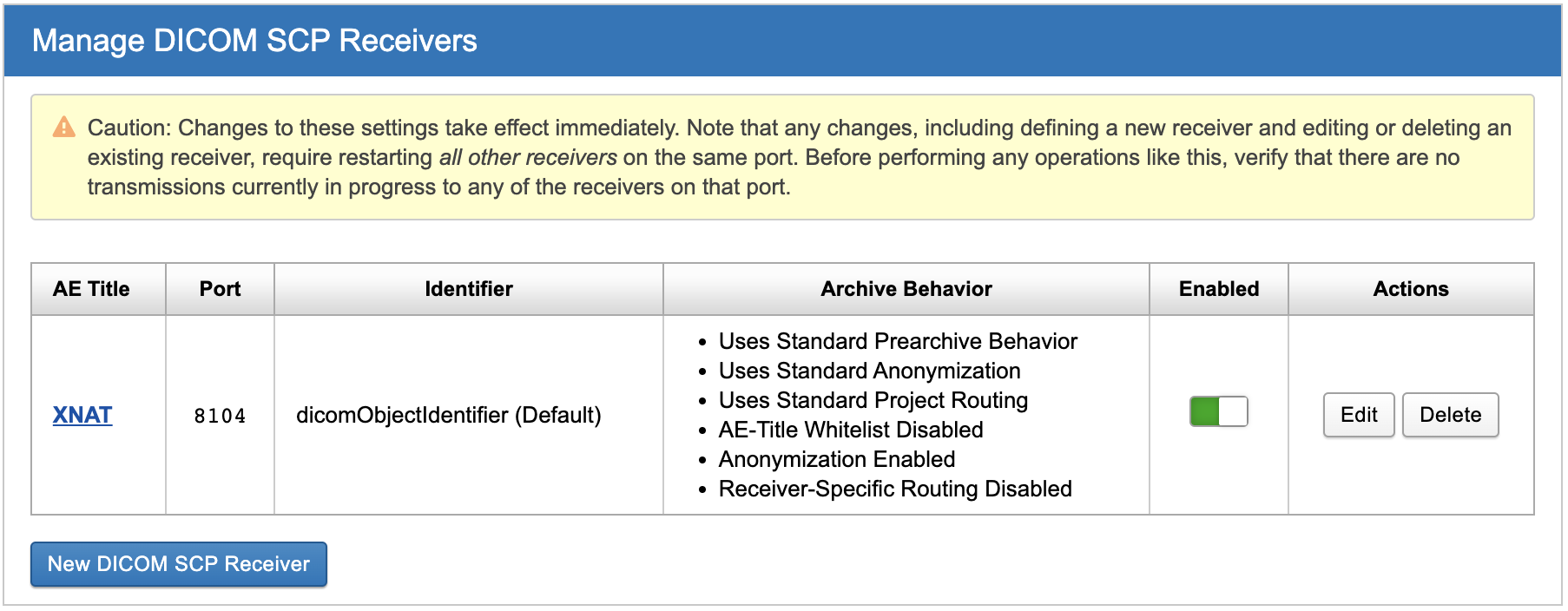Connecting XNAT to DICOM Scanners and PACS
XNAT includes an integrated DICOM C-STORE Service Class Provider (SCP) to manage connections with PACS and DICOM Application Entities. What does this mean?
C-STORE is a protocol by which DICOM data objects are sent from one application (the Service Class User, or SCU) to another (the Service Class Provider, or SCP) to be stored. In XNAT, incoming DICOM data is received by an SCP Receiver. The XNAT SCP Receiver not only stores DICOM objects, but also translates DICOM metadata into an XNAT session document. The XNAT SCP Receiver can receive data from any DICOM C-STORE SCU, including scanners or DICOM viewers such as OsiriX or DicomBrowser.
Any DICOM service is a transaction between two applications: an SCU that initiates the request and an SCP that responds. Each application is identified by the IP address of its host, the TCP port number used for the connection, and a DICOM Application Entity (AE) title, a string that names the application.
The XNAT DICOM C-STORE SCP supports multiple AEs per XNAT. Each AE has its own AE title and its own rules for determining the project, subject, and session of received objects. It is the role of a DICOM Object Identifier to implement these rules. Multiple AEs can be used in a variety of ways to make it easier to route incoming data to the correct project. More advanced manipulation of C-STORE SCP receivers can be accomplished through the XNAT DICOM SCP management API.
Global Settings Enabling or Disabling SCP Receivers
At a site-wide level, an XNAT Administrator can control whether or not to receive DICOM data via SCP. Go to Administer > Site Administration > DICOM SCP Receivers to toggle this setting, which is set to "Allowed" by default.

Connecting a PACS or DICOM AE to the Default SCP Receiver
As long as your XNAT has an enabled DICOM SCP Receiver, external PACS or DICOM AEs can set up a connection to them. XNAT can support multiple SCP Receivers, which can be connected to by any number of DICOM AEs. To manage these receivers, log in as a site administrator and go to Administer > Site Administration > DICOM SCP Receivers.

By default, XNAT ships with an active receiver with the following information:
AE Title: XNAT
Port: 8104
DICOM Anonymization: Enabled
Any DICOM CStore SCU can send DICOM objects to this DICOM CStore SCP receiver, provided there is network connectivity between the sending device and the XNAT's CStore SCP. Configure the sending SCU (e.g. Imaging scanner, PACS, workstation) with XNAT's host name, port 8104, and called AE Title of XNAT.
Configuring A New Connection / Editing An Existing Connection
Configuring a DICOM SCP receiver in XNAT is fairly simple, but there are many options for customizing the behavior of these receivers.
To learn how to configure and customize these receivers, see: DICOM SCP Receiver Configuration
As an advanced case, it is possible to set up an SCP Receiver that uses a known XNAT project ID as the AE Title, and guarantee that all incoming DICOM data routes to that project. See: How To Use a Project ID as a DICOM AE Title
Enabling or Disabling Connections
From the Manage DICOM SCP Receivers control panel in the Admin UI, you can modify existing SCP Receiver definitions whenever you want. If you click the AE Title or Edit button for a receiver, an edit dialog will open and let you change any of its settings. Upon saving, your changes will take effect immediately.
If you wish to disable a receiver, click the "Enabled" switch box for that provider. The switch box will then go from green to gray and you will no longer be able to receive data with that receiver until you enable it again by clicking the switch box.
If you want to completely delete an SCP Receiver definition, you can click on the delete button in the Actions column.